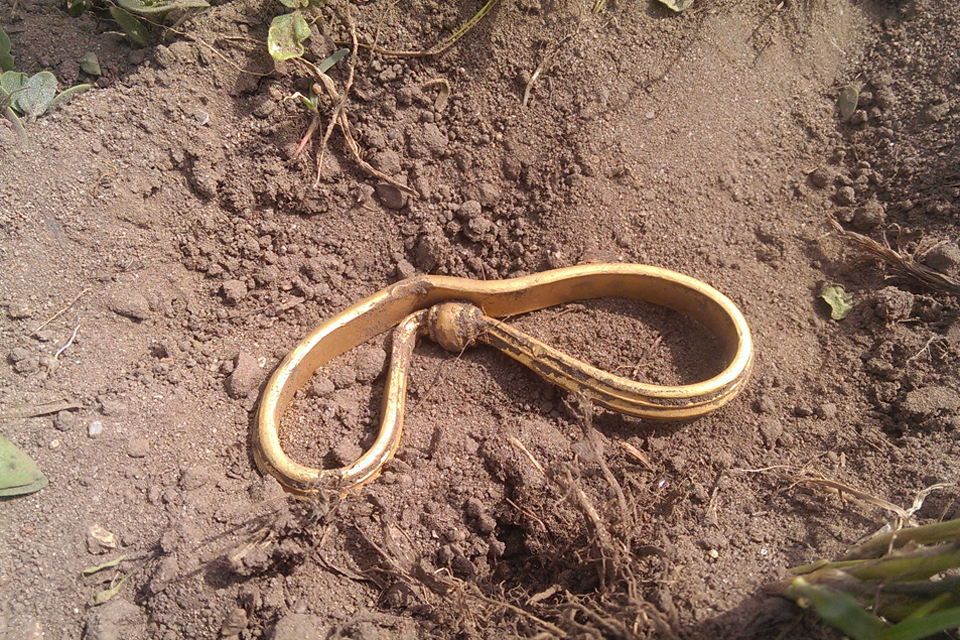It really feels as if we found gold at the end of the rainbow, tells one of the amateur archaeologists, who last week found the largest treasure of Viking gold ever discovered in Denmark
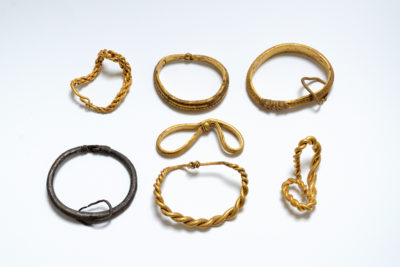
Last week three amateur archaeologists found seven bangles from the 10th century in a field near Vejen in Jutland. The amazing thing is that six of the seven are made of gold, while the last is of silver.
– When we discovered the first ring, we really felt that we had found the gold at the end of the rainbow. And then more surfaced; it was almost unreal, says Marie Aagaard Larsen, who together with her husband Christian Nedergaard Dreiøe and their common friend Poul Nørgaard Pedersen is one of the three happy finders.
It took only about ten minutes to find the first three bangles; afterwards a phot was sent quickly to the local museum in Sønderskov where the curator was quick to secure the place.
Already in 1911, a gold chain was discovered and it was this fact, which led the amateur archaeologists to explore the place once more.
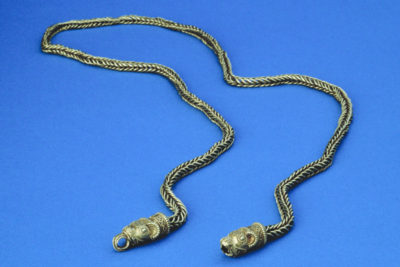
– At the museum we had talked about whether it would be interesting to explore the area with a metal detector, where the gold chain weighing 67 grams was found back in 1911. But that amateur archaeologists in the course of a few days would find seven Viking bangles Viking, is something which I could not imagine, not even in my wildest dreams might imagine, says Lars Grundvad. He is is reasonably convinced that the gold chain, which was found in 1911, is associated with the seven newfound bangles.
The chain found in 1911 is characterised by its Jelling style, as is one of the bangles. Vejen is located 25 km from Jelling and it seems possible to speculate upon a connection to the famous Viking fortress cum burial monument there, as treasures of gold are extremely rare. The viking age was one of silver, explains Peter Pentz, who is curator at the National Museum in Copenhagen.
Another possible connection is to the high-ranking Viking, Ravninge-Tue, who was responsible for the construction of one of the mounds at Jelling and who raised a stone-ship to commemorate his mother eleven km from where the find was made (Bække).
Viking Elite and Unique Treasure
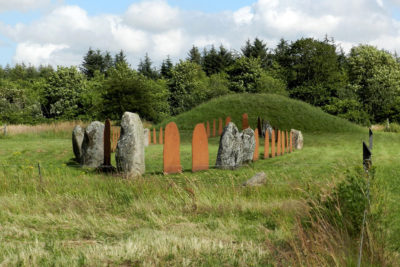
Peter Pentz explains that until last week a treasure from Vester Vedsted in Southwestern Jutland, was the largest ever found in the neighbourhood. This weighed 750 gr. The new treasure weighs 900 gr; together with the chain and the silver bangle, it exceeds more than a kilo. He believes the bangles should be understood as “edsringe” or “oath rings” – the golden gifts presented by Viking chieftains to their trusted men, the elite at that time.
Why did such wealth end up in the ground? This question puzzles both Peter Pentz and Lars Grundvad.
– The treasure might be buried as part of cultic act. However, another – and perhaps more likely explanation is, that the treasure was buried as part of a precautionary act; and then, never reclaimed, says Peter Pentz, adding, It would be very interesting to examine the location closer as this might yeld additional information as to why this valuable treasure ended up there, in the ground.
Lars Grundvad agrees and is already speculating on how to secure funds for a proper survey and excavation: hope is to get into the ground, perhaps already this autumn.
– The treasure was found in Frøs Herred. Frøs means Freyr, who was was a Viking fertility god. The golden ring from Tissø (weighing 1,83 Kg) was found at a royal estate. The hope – the dream – is to either confirm the cultic aspect; or locate a royal Viking residence nearby.
The plan is to exhibit the new treasure at Sønderskov Museum for a short while, before it is sedn to the National Museum in Copenhagen for further study and evaluation. Based on this, The Team Rainbow Power will get a very substantial treasure trove compensation.
New Finds December 2016
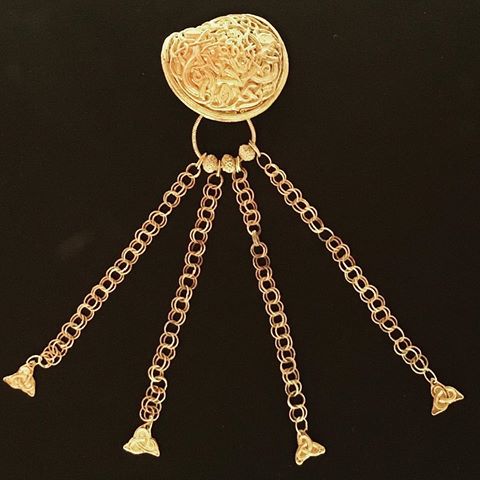 Unknown to a very select number of archaeologists, the site of the find was not revealed. The reason was that the archaeologists speculated there might be more hidden in the field. Late autumn, they returned to carry out a scientific exploration of the site of the golden bangles. The result was, to say the least beyond expectations.
Unknown to a very select number of archaeologists, the site of the find was not revealed. The reason was that the archaeologists speculated there might be more hidden in the field. Late autumn, they returned to carry out a scientific exploration of the site of the golden bangles. The result was, to say the least beyond expectations.
Nearly forty more pieces and fragments weighing more than 500 gr. were discovered. One of these was a unique fibula with hanging “bling” plus several pendants set with stones worked in delicate techniques like granulation etc. Another find was the beatiful Thor’s hammer, which may have been hanging from the chain found in 1911. in the After having worked through the field systematically, the archaeologists were able to announce that the find consisted of nearly fifty pieces or fragments thereof. Also, they found traces of a Viking settlement. At a later stage, the plan is to excavate this to get a sense of the socio-cultural milieu of the elite residence, where the treasure is believed to have been hidden sometime in the second half of the 10th century. (Postscript added dec. 2016).
SOURCE:
Press Release: Amatørarkæologer finder Danmarks største guldskat fra vikingetiden
FEATURED PHOTO:
The sixth Viking gold bangle surfacing from the ground. Photo: Poul Nørgaard Pedersen
